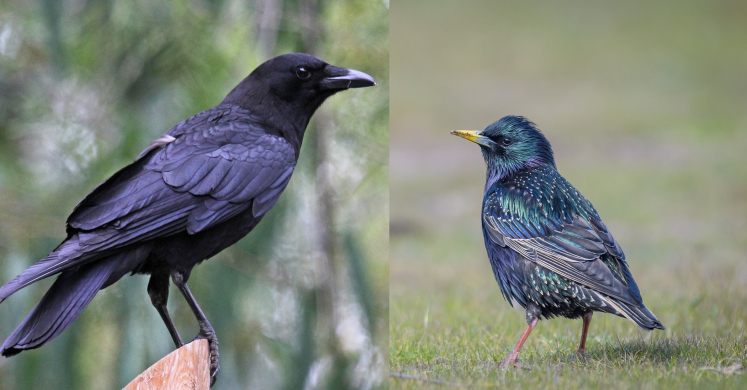Blog

#bioPGH Blog: Feathered Copycats
 A resource of Biophilia: Pittsburgh, #bioPGH is a weekly blog and social media series that aims to encourage both children and adults to reconnect with nature and enjoy what each of our distinctive seasons has to offer.
A resource of Biophilia: Pittsburgh, #bioPGH is a weekly blog and social media series that aims to encourage both children and adults to reconnect with nature and enjoy what each of our distinctive seasons has to offer.
It’s happened two mornings in a row now: I was taking my dogs on their morning walk, when I jumped at the sound of a throaty scream coming from the trees! Add in the dense misty fog of the last few days, and the scene was set for the opening of movie that would probably not be Maria-friendly (no scary movies, thank you). But both times in a row, after the quick adrenaline spike, I looked into the trees and noted two possible screaming culprits: starlings and crows. Both mornings, a small flock of starlings has been roosting in a cluster of trees along our morning walk route, and though our neighborhood almost always has some crows, a handful have recently been spending their mornings in trees right alongside the starlings. So who was it? Who has been giving me the jump-scare two days in a row? Let’s weigh some evidence and find out.
First things first! Technically, within the study of mimicry, there are a few different operating definitions of mimicry that range from general to specific. A classic definition of mimicry comes from Vane-Wright (1980): “Mimicry is defined in terms of a system of three living organisms, model, mimic and operator (signal-receiver), in which the mimic gains in fitness by the operator identifying it with the model.” Other operating definitions in biology today generally reference back to that definition, but have a slight modification. For example, Dalziell and Welbergen (2016) defines mimicry as when “{the individual who sees or hears the mimic} perceives the similarity between a mimic and a model and as a result changes its behavior in a manner that provides a selective advantage to the mimic.” An example of a broad definition comes from Goller and Shizuka (2018) “imitation of all types of non‐conspecific sounds: other animals, anthropogenic (e.g., dog whistle, chainsaw), and environmental (e.g., water drip, leaves rustling) noise.” And then, once we are beyond the actual definitions of mimicry, there are different forms of mimicry, ranging in form from matching appearances, to copying behavior, to copying sounds; and a few of the possible reasons behind the mimicking can include tricking would-be predators, prey, or sending signals to potential mates.
The sounds, the “screaming,” I heard came from a particular type of copying – vocal mimicry. Vocal mimicry (copying the sounds from the environment) is a feature of at least 339 songbirds around the world, including both the starlings and crows I’ve seen when hearing the “scream.” It is not exactly known why some birds mimic other sounds, but there are some possibilities out there. For example, mockingbirds may be trying to impress potential mates with a large repertoire of songs (and indeed, they can learn over 200 songs!), whereas blue-jays may be trying to either ward off predators or defend territories by imitating a red-tailed hawk call. A legendary example of avian vocal mimics, though, is the lyrebird – you just have to hear them, check out the video below!
So, now about the eerily human-like scream, who did that? For comparison, here are a few examples of crow and starling calls (though I will say, both birds have a range of songs and calls on their, without copying anything.)
As I mentioned earlier, both starlings and crows can make a wide range of sounds before they even begin copying something they may have heard. So I started digging through the Macauly Library online to hear if either already made something along the lines of the scream. I did come across some odd crow calls that gave me pause, like the trilling one below:
And I also searched through starling flight calls – they do have one known to sound like a bird “scream.”
Of course, if it’s a mimic, the sound wouldn’t necessarily have to resemble a normal song or call from the bird’s repertoire. And nothing I came across quite resembled the startling sound I heard the past few mornings. But, if any of those crows or starlings have been in the area for some bit of time, they have most likely heard a variety of yells and even play “screams” from the recreational facilities nearby. So it’s not a stretch at all for either species to have learned to imitate a human noise.
Well, in the end, whichever species it was, I have to be an awe of abilities in nature. The sound might have given me a jumpstart two mornings in a row, but it’s amazing to think of the learning and vocal physiology that has to go into learning to impressively mimic another sound. Well, as always, it’s just another to keep exploring our wild world!
Continue the Conversation: Share your nature discoveries with our community by posting to Twitter and Instagram with hashtag #bioPGH, and R.S.V.P. to attend our next Biophilia: Pittsburgh meeting.
Image Credits: Crow, Dick Daniels CC-BY-SA-3.0; starling, Becky Matsubara CC BY 2.0

